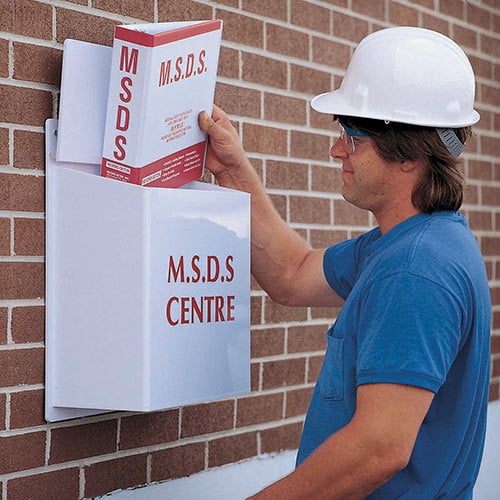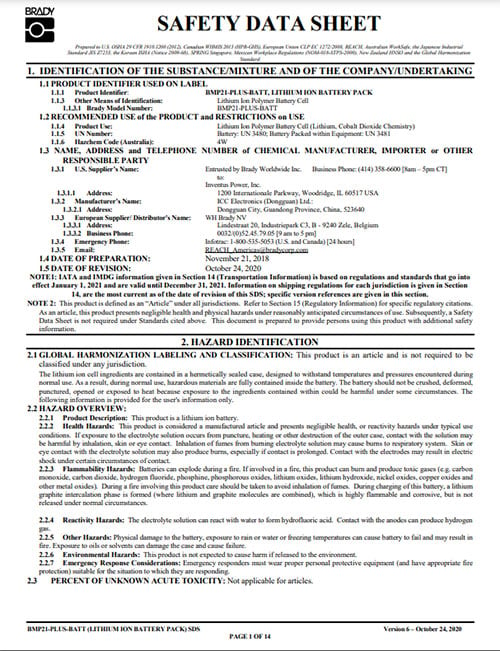Hazardous Chemical Safety: What’s the Difference Between MSDS and SDS?
When you're a compliance manager or part of a safety crew, you know how critical it is to take the necessary precautions during the transportation of hazardous chemicals. It's key to avoiding accidents and putting safety first. And it's why you and your team must know precisely how to go about chemical handling and regulatory compliance to stay safe.
Hazardous materials need to be clearly labeled to notify workers of the potential dangers of the chemicals they deal with. But additional critical information means an even safer workplace where your team has the best chance of going home safe and sound at the end of the day. Make on-demand labels with a GHS label printer to ensure you are always up to date with GHS Label Requirements.
It used to be that this important safety information was provided via a Material Safety Data Sheet, or MSDS. The MSDS provided information on the potential health and safety hazards of a particular chemical. Useful information, for certain, but an updated document, called a Safety Data Sheet (SDS), became the new standard you can rely on — and continue to rely on — for even more instruction for a safer workplace.
We'll spell out the details and differences between the SDS and MSDS, but first, a little background.
Where it all started: OSHA's HazCom standard
OSHA's Hazard Communication Standard(PDF opens in a new tab) (HCS), also known as HazCom, ensures that companies provide hazardous chemical handling information to employees. Written in the early 1990s, the standard required chemical suppliers to provide an MSDS with this important information.
In 2012, OSHA revised their HazCom standards, the intent being to increase workplace safety and make it easier for workplaces to properly use, store and dispose of chemicals. The new standard — the SDS, which officially replaced the MSDS — saw many improvements in consistency and format and is the ongoing standard for health and safety information on hazardous chemicals.
Why did OSHA make the change?
Simply put, the Safety Data Sheet is a simpler, more consistent and more effective way to communicate the hazards of chemicals. Because of the lack of standardization and continuity in Material Safety Data Sheets, it became challenging to find and correct errors because of the varied structure, format and detail. Luckily, standardizing the data across the globe resolved this issue — and helped match the United Nations' Globally Harmonized System of Classification and Labeling of Chemicals (GHS). GHS training materials are a great resource for organizations to familiarize workers with these guidelines. These positive changes all contribute to making it easier for employees to follow the guidelines. Stay updated with the GHS Labeling Requirements. After all, the lives of your crew are at stake.
What's at risk: workplace fatality statistics
When hazardous materials aren't labeled correctly, workers are exposed to several hazards. Incorrect or incomplete labels can lead to employees mishandling chemicals, which can unfortunately result in severe injury or even death. According to the Bureau of Labor and Statistics(opens in a new tab), in 2020, there were 4,764 fatal work injuries recorded in the United States — that means a worker died every 111 minutes from a work-related injury.
Digging deeper: some differences between MSDS and SDS
With time and experience, we acquire more knowledge — and things evolve. It's no different with the Safety Data Sheet replacing the MSDS. We know more now. And have the opportunity to share it for the sake of crew safety.
If you've been accustomed to seeing an MSDS, it's helpful to understand the differences and updates that an SDS provides, so you can adapt and adopt with confidence. Let's look at a few examples:
- Safety Data Sheets provide more standardization and a 16-section format, as opposed to the prior 9-section MSDS format, that leaves no room for confusion — critically important when it comes to the safe handling of dangerous chemicals
- Safety Data Sheets are provided in a consistent, regulated format, making it easier for employees to find the information they need to stay safe
- Safety Data Sheets provide more-easy-to-digest information through the use of pictograms and labels for hazardous materials
Reference this handy chart to see how the MSDS evolved into the more consistent and easy-to-understand standards found in the Safety Data Sheet:
| Material Safety Data Sheet (MSDS) | Safety Data Sheet (SDS) | |
|---|---|---|
| Identity of the chemical |  |
 |
| Physical and chemical properties of the chemical (flammability and explosive properties) |  |
 |
| Health hazards of the chemical |  |
 |
| First-aid measures for exposure to the chemical |  |
 |
| Fire-fighting procedures for the chemical |  |
 |
| Protective measures for handling and using the chemical |  |
 |
| Hazard statement |  |
|
| Signal word |  |
|
| Pictograms |  |
|
| Ingredients and percentages of mixed chemicals |  |
Back in time: What's an MSDS?
A Material Safety Data Sheet (MSDS) is a document, normally many pages long, that travels with or ahead of hazardous chemical shipments, warning users of the specific dangers of such products and guidance on their safe handling, storage and disposal. While an MSDS was a helpful document that carried key safety information, it lacked consistency in format and details, making it sometimes difficult to follow.

In the now: What’s a Safety Data Sheet (SDS)?
An SDS goes beyond the information in an MSDS, addressing a specific chemical's identification, potential hazards and several more points of information.
As illustrated, the SDS provides more information and standardizes safety for all industries. This means that all workers — no matter what company they work for — will be given an SDS that contains the same information. Additionally, an SDS must now include a section on environmental hazards, which the MSDS did not cover.
While both documents contain important health and safety information, it is essential to understand that they are not the same document. If you are working with a hazardous chemical, be sure to familiarize yourself with the SDS, as it is now the standard for safety.

GHS Signal words
Standardizing the SDS also brought about the standardization of GHS label requirements(opens in a new tab) — all GHS labels must now include the words "danger" or "warning." These easy-to-understand words inform employees of the potential hazards when working with or around the hazardous material in question. They also provide essential information about what steps should be taken in the event of exposure.
Before the change to the SDS as the standard for chemical safety information, these words could have meant different things on a datasheet depending on the chemical supplier — causing confusion for employees trying to understand what they're working with and how it should be handled.
Now, all employees can know that "danger" indicates that a chemical is more hazardous than one that has a "warning" label. These universal definitions make it easier for employees to understand what they're dealing with when handling hazardous materials in the workplace.
Requirements for the Safety Data Sheet (SDS)
There are 16 sections of a GHS-formatted SDS sheet. Much of the information comes in the form of signs, pictograms and labels. These 16 points of information let workers know the following:
- Identification: Find the name of the chemical, including common variations and synonyms, here. The manufacturer / distributor, emergency contact information and recommended / restrictions of use are also outlined.
- Hazard identification: Get a description of all the chemical hazards and how they affect human health.
- Composition information: You'll see the chemical's physical and chemical properties, potential health effects, common uses and exposure limits (when available).
- First-aid measures: Note the recommended first-aid steps to take if there's a chemical exposure, including details on how to remove the person from the area, symptoms of exposure and contact information for the poison control center and other health care facilities.
- Firefighting measures: Read how to extinguish a fire, what personal protective equipment is recommended for firefighters and the chemical's burning properties.
- Accidental release measures: Outlining what measures should be followed if there's an unintentional release, including the steps to follow, evacuation procedures and other first-aid procedures.
- Handling and storage instructions: Here workers get the necessary information on how to safely handle and store the chemical, including restrictions on exposure, incompatibilities and special precautions.
- Exposure / personal protection controls: This section must be filled out for all chemicals that require the use of personal protective equipment. This includes workplace controls, exposure limits, engineering controls and information on the type of personal protective equipment needed.
- Physical and chemical properties: Here you'll see all the physical and chemical characteristics of the chemical.
- Stability and reactivity: This section includes information on the chemical's stability and how it may react with other materials.
- Toxicological information: Important information on the chemical's toxicity, as well as its carcinogenicity, reproductive toxicity and mutagenicity are found in this section. Additionally, it lists all routes of exposure and symptoms of toxicity.
- Ecological information: This portion includes information on the chemical's toxicity towards non-human organisms, including fish and plant life. It also discloses any potential environmental hazards you should be aware of when disposing of the chemical.
- Disposal considerations: Provides information on properly disposing of the chemical, including any necessary permits or regulations.
- Transport considerations: This section includes information and identification markers on how to handle and transport the chemical.
- Regulatory information: This section lists all the laws and regulations that apply to the chemical.
- Other information: This section may include any additional information that is deemed necessary, including the date of preparation and last inspection.

When digging in to understand the differences between these two important documents, one word describes what's happened... evolution. While the MSDS certainly carried important information and provided safety guidelines for handling dangerous chemicals, it did so with a lack of consistency and standardization. In the years that have transpired since the MSDS was the go-to document, we've learned a lot. And the Safety Data Sheet is a reflection of that learning, requiring the addition of more detailed information about a chemical, as well as a format that works across the board, ensuring that everyone gets the same information. And consistent, standardized information is the key to keeping your crew as safe as possible when handling dangerous chemicals.
Look to the Safety Data Sheet as your go-to document that makes it as easy as possible to follow the guidelines and send everyone home safely at the end of the day.
